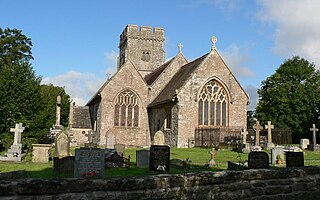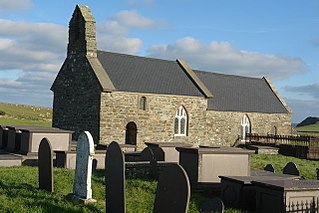
Sabine Baring-Gould of Lew Trenchard in Devon, England, was an Anglican priest, hagiographer, antiquarian, novelist, folk song collector and eclectic scholar. His bibliography consists of more than 1,240 publications, though this list continues to grow.
Salomon was a late 5th century Cornish 'warrior prince', possibly a King of Cornwall. His feast day takes place on the 18 October. He was the father of the Cornish bishop Saint Cybi.

Gwened, Bro-Gwened or Vannetais is a historic realm and county of Brittany in France. It is considered part of Lower Brittany.

St Hilary is a village in the Vale of Glamorgan, Wales. It is located just south of the A48, about a mile southeast of the market town of Cowbridge. The village has a population of about 260, in approximately 80 houses. Notable landmarks in the vicinity include The Bush Inn, the Church of St Hilary, the Old Beaupre Castle, New Beaupre, Coed Hills and St. Hilary mast.

The Parish Church of St Hilary is a Grade II* listed Anglican church in the village of St Hilary in the Vale of Glamorgan, south Wales. It is one of 11 churches in the Parish of Cowbridge. It became a listed building on 22 February 1963.

Saint Eigen, Eurgen, Eurgain or Eurgan was the legendary, and possibly historical first female Christian saint among the Britons. Her name has doubtfully been linked to two Welsh churches and is found in manuscripts from the collection of Iolo Morganwg making historical evidence of her existence dubious and limited.
Saint Gwrddlew or Gwrtheli, Gartheli, was a pre-congregational saint of 5th century medieval Wales.

Saint Eigrad or Eugrad was a sixth-century Welsh saint and the founder of St Eugrad's Church in Llaneugrad, Anglesey.

Saint Noyale, also known as Noaluen, was a semi-legendary 5th-century Celtic saint and virgin martyr. She is a popular saint in both Brittany and Cornwall, where she is memorialized at Newlyn East. According to legend, it is there that a fig tree growing from the south wall of the church grew from Noyale's staff. A holy well nearby was the site of her martyrdom. She was one of the numerous Celtic settlers who travelled to Brittany during the Anglo-Saxon invasion of England.

Saint Einion Frenin was a late 5th- and early 6th-century Welsh confessor and saint of the Celtic Church. His feast day was originally given as 9 February, although this had moved to the 10th or 12th by the 16th century and is no longer observed by either the Anglican or Catholic church in Wales.
Saint Gwrthwl is a Pre-Congregational Saint of Powys in Wales.

A Saint Ilar is listed among the 6th-century saints of Wales and is the probable namesake of Llanilar in Ceredigion and its former hundred of Ilar. His feast day is variously given as 13, 14, or 15 January, but is no longer observed by either the Anglican or Catholic church in Wales.
Saint Dyfnog was an early Welsh saint. His feast day is 13 February.

Ystrad Marchell was a medieval commote in the cantref of Ystlyg in the Kingdom of Powys. It roughly coincides with the parish of Welshpool.
Clydog was a sixth-century Welsh king of Ergyng who became a saint. His feast day is traditionally held on 3 November but is also celebrated on 19 August.
Saint Tydecho was a 6th century saint of Wales.
Tyfanog also known as Tauannauc is a Pre-Congregational Saint of Wales. He was a preacher of the Gospel who arrived in Briton in AD 186 and ended his days on Ramsey Island. He established a community during the Roman era on Ramsey Island. He is said to have been murdered by the natives of Ramsey Island and that his body swam across to where the chapel was built. A feast day celebrates his life November 25.

Rhwydrys is a 6th-century pre-Congregational saint of Wales. His feast day is on 1 November.
Clydwyn is a 6th-century Pre-Congregational Saint of Wales.











